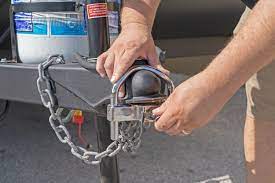The Importance of RV Safety Equipment
When hitting the open road in your RV, safety should always be a top priority. Properly equipping your recreational vehicle with essential safety gear not only protects you and your passengers but also ensures a smooth and secure journey. Let’s explore some crucial RV safety equipment that every traveler should have on board:
Fire Extinguisher
An RV fire extinguisher is a must-have item to deal with potential fires quickly and effectively. Make sure it is easily accessible and regularly checked to ensure it is in good working condition.
Carbon Monoxide Detector
Carbon monoxide is a silent killer that can leak from appliances like stoves or heaters in an RV. A carbon monoxide detector can alert you to dangerous levels of this odorless gas, providing vital early warning to prevent carbon monoxide poisoning.
First Aid Kit
A well-stocked first aid kit is essential for handling minor injuries or medical emergencies while on the road. Include items such as bandages, antiseptic wipes, pain relievers, and any necessary prescription medications.
Emergency Roadside Kit
In case of breakdowns or other roadside emergencies, an emergency kit containing items like reflective triangles, jumper cables, flashlight, tire pressure gauge, and basic tools can be a lifesaver.
Tire Pressure Monitoring System (TPMS)
Maintaining proper tire pressure is crucial for safe RV travel. A TPMS helps monitor tire pressure and temperature in real-time, alerting you to any issues before they lead to a blowout or loss of control.
Backup Camera System
A backup camera system enhances visibility when reversing or maneuvering your RV, reducing the risk of accidents or collisions with obstacles behind the vehicle.
By investing in these essential RV safety equipment items and staying vigilant while on the road, you can enjoy peace of mind knowing that you are well-prepared for any unexpected situations that may arise during your travels.
Top 5 Benefits of RV Safety Equipment: Ensuring Secure and Protected Travels
- Enhances overall safety and security for you and your passengers while traveling in an RV.
- Provides peace of mind by offering protection against potential hazards such as fires, carbon monoxide leaks, and accidents.
- Helps you comply with safety regulations and standards, ensuring a safer journey on the road.
- Equips you to handle emergencies effectively with tools like fire extinguishers, first aid kits, and emergency roadside kits.
- Improves driving visibility and awareness with features like backup camera systems and tire pressure monitoring systems.
7 Key Concerns Regarding RV Safety Equipment: Costs, Installation, and Storage Challenges
- Cost of purchasing and maintaining safety equipment can add up
- Some safety devices may require professional installation, leading to additional expenses
- Limited space in an RV may make it challenging to store all necessary safety equipment
- Regular maintenance and testing of safety gear can be time-consuming
- False alarms from certain safety devices can be annoying and disruptive
- Certain safety equipment may have a limited lifespan and need replacement periodically
- Overreliance on technology-based safety equipment may lead to complacency in manual safety checks
Enhances overall safety and security for you and your passengers while traveling in an RV.
Enhancing overall safety and security for you and your passengers while traveling in an RV is a crucial benefit of having proper safety equipment onboard. With essential gear like fire extinguishers, carbon monoxide detectors, first aid kits, and tire pressure monitoring systems in place, you can significantly reduce the risks associated with emergencies on the road. By prioritizing safety measures, you create a secure environment that promotes peace of mind and ensures a smoother and more enjoyable travel experience for everyone on board.
Provides peace of mind by offering protection against potential hazards such as fires, carbon monoxide leaks, and accidents.
RV safety equipment offers a valuable sense of security by safeguarding against various potential risks, including fires, carbon monoxide leaks, and accidents. By having the necessary safety gear onboard, RV travelers can enjoy peace of mind knowing that they are prepared to handle emergencies effectively and protect themselves and their companions from harm. This proactive approach to safety ensures a more relaxed and worry-free travel experience, allowing adventurers to focus on enjoying the journey without unnecessary anxiety about potential hazards.
Helps you comply with safety regulations and standards, ensuring a safer journey on the road.
Having proper RV safety equipment not only enhances your safety but also helps you comply with safety regulations and standards, ensuring a safer journey on the road. By adhering to these regulations and standards, you are not only protecting yourself and your passengers but also contributing to a more secure environment for all road users. With the right safety gear in place, you can confidently navigate the highways and byways, knowing that you are well-prepared to handle any unforeseen circumstances that may arise during your travels.
Equips you to handle emergencies effectively with tools like fire extinguishers, first aid kits, and emergency roadside kits.
RV safety equipment plays a crucial role in equipping travelers to handle emergencies effectively. Tools such as fire extinguishers, first aid kits, and emergency roadside kits provide the necessary resources to respond promptly and decisively in unexpected situations. In the event of a fire, medical emergency, or breakdown on the road, having these essential items readily available ensures that RV occupants can take swift action to mitigate risks and ensure their safety. By being prepared with the right tools, RV travelers can navigate emergencies with confidence and safeguard themselves and their companions during their adventures.
Improves driving visibility and awareness with features like backup camera systems and tire pressure monitoring systems.
Enhancing driving visibility and awareness is a significant advantage of RV safety equipment. Features such as backup camera systems provide a clear view of the surroundings when reversing or maneuvering, reducing blind spots and minimizing the risk of accidents. Additionally, tire pressure monitoring systems help maintain optimal tire pressure levels, ensuring better handling and stability on the road. By utilizing these advanced technologies, RV owners can improve their overall driving experience while prioritizing safety for themselves and others on the road.
Cost of purchasing and maintaining safety equipment can add up
One significant drawback of RV safety equipment is the associated costs of purchasing and maintaining these essential items. While investing in safety gear is crucial for ensuring the well-being of passengers and preventing accidents, the expenses can quickly accumulate. From buying fire extinguishers, carbon monoxide detectors, first aid kits, to installing tire pressure monitoring systems and backup camera systems, the initial outlay and ongoing maintenance costs can put a strain on your budget. However, prioritizing safety should always be a top concern when traveling in an RV, as the potential risks of not having adequate safety equipment far outweigh the financial burdens involved.
Some safety devices may require professional installation, leading to additional expenses
Some RV safety equipment may come with the drawback of requiring professional installation, which can result in additional expenses for RV owners. Devices such as backup camera systems or tire pressure monitoring systems often need to be installed correctly to ensure optimal functionality and reliability. While the added cost of professional installation may be a downside, it is crucial to prioritize safety on the road and ensure that these devices are properly set up to effectively enhance the overall safety of your RV travels.
Limited space in an RV may make it challenging to store all necessary safety equipment
Limited space in an RV can present a significant challenge when it comes to storing all the necessary safety equipment. With the compact layout of most recreational vehicles, finding adequate storage space for items like fire extinguishers, first aid kits, and emergency roadside kits can be a struggle. This limitation may require RV owners to prioritize essential safety gear and carefully consider the most efficient ways to store them without cluttering the living area. Despite this con, ensuring that critical safety equipment is accessible and well-organized remains paramount for safe travels on the road.
Regular maintenance and testing of safety gear can be time-consuming
Regular maintenance and testing of RV safety equipment can be a significant con for RV owners. Ensuring that fire extinguishers are in working order, carbon monoxide detectors are functional, and first aid kits are stocked can be time-consuming tasks that require attention to detail. Additionally, checking and maintaining items like emergency roadside kits and tire pressure monitoring systems demand regular dedication to ensure they are ready for use in case of an emergency. While these efforts may take up valuable time, the peace of mind and safety they provide on the road make them essential responsibilities for any responsible RV owner.
False alarms from certain safety devices can be annoying and disruptive
False alarms from certain safety devices in RVs can indeed be annoying and disruptive, potentially causing unnecessary stress and distractions during your journey. While these devices are designed to enhance safety and provide early warnings, frequent false alarms may lead to complacency or even the temptation to disable the equipment altogether. It is essential for RV owners to carefully select reliable safety devices and regularly maintain and test them to minimize the occurrence of false alarms while ensuring that genuine safety threats are promptly addressed.
Certain safety equipment may have a limited lifespan and need replacement periodically
Certain safety equipment used in RVs may have a limited lifespan and require periodic replacement, which can be a drawback for RV owners. Keeping track of the expiration dates or recommended replacement intervals for items like fire extinguishers, carbon monoxide detectors, and even first aid supplies adds an extra layer of maintenance responsibility. Failure to replace these safety components in a timely manner could compromise the effectiveness of the equipment when it is needed most, potentially putting occupants at risk during emergencies. Regularly updating and maintaining safety equipment is essential to ensure optimal protection and peace of mind while traveling in an RV.
Overreliance on technology-based safety equipment may lead to complacency in manual safety checks
Relying too heavily on technology-based safety equipment in RVs can inadvertently foster a sense of complacency towards conducting manual safety checks. While tools like tire pressure monitoring systems and backup cameras offer valuable assistance, they should not replace the importance of regular visual inspections and hands-on assessments of critical safety components. Overreliance on technology may lead to overlooking potential issues that could be detected through traditional methods, ultimately compromising overall safety on the road. It is essential for RV owners to strike a balance between utilizing advanced safety features and maintaining a proactive approach to manual safety checks to ensure comprehensive protection while traveling.




